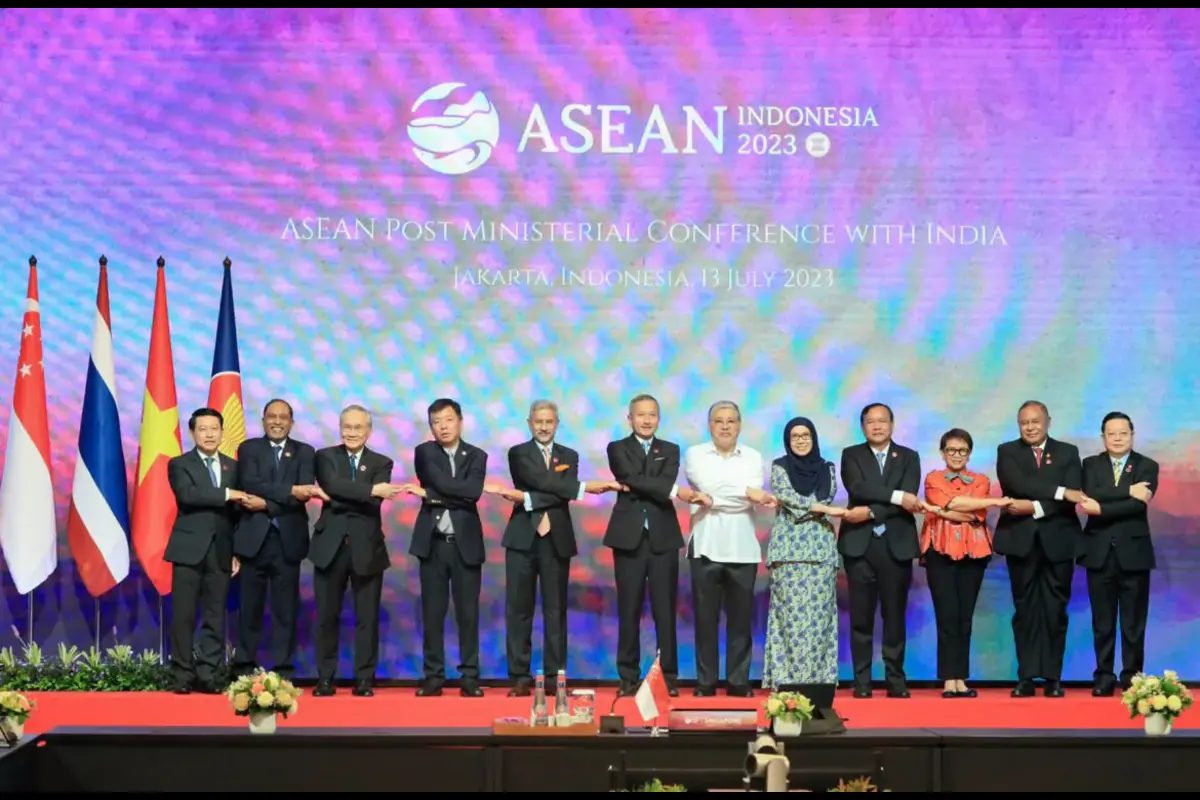
Amidst shifting global dynamics and India’s transformative transitions, the ASEAN-India alliance emerges as a formidable force.
From being Regional Dialogue Partners in 1992, it matured into a 2022 Comprehensive Strategic Partnership and was propelled by Prime Minister Narendra Modi’s Act East Policy with commerce, culture, security, connectivity, and cooperation intertwined.
PM Modi’s forthcoming Jakarta visit amidst the G20 Summit signifies commitment to ASEAN, the Indo-Pacific outlook, according to Maheep, a leading analyst of India’s Foreign Policy. He has been teaching and researching international relations and global politics over a decade.
As ties deepen across trade, defence, cultural exchanges, and geopolitical strategy, the ASEAN-India partnership stands strong. A shared vision propels mutual growth amid evolving global dynamics.
Amidst the shifting tides of the global order and India’s own transformative politico-economic transitions, the ASEAN-India relationship emerged as a force to reckon with. The disintegration of the erstwhile USSR in 1991 marked the culmination of the Cold War era, coinciding with India’s transition from a mixed economy to the realms of liberalization, privatization, and globalization.
This evolving context set the stage for a new chapter in international affairs by laying the foundation for the blossoming relationship between ASEAN and India. As the world redefined itself and India reshaped its identity, the convergence of these changes paved the way for a partnership that would form the course of regional dynamics and global cooperation.
India’s formal engagement with the Association for Southeast Asian Nations (ASEAN) began in 1992 as a Regional Dialogue Partner, and this relationship kept on becoming stronger with time eventually culminated into a Comprehensive Strategic Partnership between India and ASEAN in 2022.
Scheduled from September 5 to 7, Prime Minister Narendra Modi’s forthcoming visit to Jakarta for the India-ASEAN and East Asia Summits, even amidst his commitments at the G20 Summit on September 9-10, symbolizes not only a remarkable gesture but also underscores India’s robust ASEAN ties.
This visit reaffirms ASEAN’s central role in India’s foreign policy vision, particularly concerning the Indo-Pacific, Southeast, and East Asia. India and ASEAN have a multifaceted and long-standing relationship that spans many domains, including cultural, economic, political, and security.
India’s engagement with ASEAN got a major fillip with the formulation of India’s Act East Policy which evolved out of the Look East Policy (LEP) formulated in the ‘90s, by PM Narendra Modi in 2014. LEP was basically an economic strategy whereas Act East Policy (AEP) added geostrategic dimensions to it.
AEP also brought India’s Northeast region to the centre of India’s developmental as well as geopolitical strategy. AEP is geared towards developing markets and connectivity links with Southeast Asia, and this Act East (through Northeast India) is now becoming Act Indo-Pacific policy.
Under AEP, the regional connectivity between India and ASEAN countries is emerging with India’s Northeast region as a focal point for multimodal and intermodal infrastructure development between the two regions. A renewed focus on the 3Cs – Commerce, Culture and Connectivity along with maritime security, climate change, disaster management, traditional and non-traditional security aspects now encompass the India-ASEAN relationship.
Initially, the inter-regional linkage between India and Southeast Asia was limited to that of sea and air. Of late, realisation dawned upon the leaders that for an effective economic relationship between the two regions, road connectivity is of paramount importance. In this regard, several modes of connectivity projects were initiated by India in partnership with the Japanese government, the World Bank, and the Asian Development Bank.
The objective was to bind the two regions in closer connectivity to maximally realise the hitherto unexploited economic potential of both regions in the areas of trade, commerce and investments. Some significant regional connectivity projects include the India Myanmar-Thailand Trilateral (IMT) Highway and the Kaladan Multimodal Transit Transport Project.
The IMT Trilateral Highway aims to connect Moreh in Manipur, India to Mae Sot in Tak province, Thailand via Bagan and Mandalay in Myanmar with an approximate stretch of 1,360 kilometres. The Kaladan Multimodal Transit Transport Project is a multimodal connectivity project to enable the shipping of freight from India’s north-eastern region to Myanmar, providing an alternate mode for transit and transportation of goods.
The connectivity projects no longer remain limited to physical connectivity but an overlying emphasis is also being put on digital connectivity. In this regard, digital connectivity projects have been scaled up with Cambodia, Lao PDR, Vietnam and Myanmar.
India and ASEAN have a robust trade and investment relationship as well. They have a Free Trade Agreement (FTA) in goods since 2010, and in services and investment since 2015. The long pending review of the existing FTA seems now a work in progress and is expected to be concluded by 2025.
The bilateral trade between India and ASEAN reached USD 86.9 billion in FY 2020-21, making ASEAN India’s fourth-largest trading partner. The trade basket itself is transforming from trade in agricultural raw materials and food to trade in manufactured products, according to Maheep.
The development cooperation between the two parties has also been gaining traction. India has established three funds to support cooperation projects with ASEAN member countries which include the ASEAN-India Cooperation Fund, the ASEAN-India Green Fund, and the ASEAN-India Science and Technology Development Fund.
These aim to provide the ASEAN nations with technical assistance and capacity-building through initiatives like the Indian Technical and Economic Cooperation (ITEC) programme, the Initiative for ASEAN Integration (IAI), and the Mekong-Ganga Cooperation.
Sharing a rich cultural heritage and civilizational links dating back to the ancient period, India and ASEAN are also witnessing growing people-to-people and cultural ties. Various platforms such as the Delhi Dialogue, the ASEAN-India Network of Think Tanks, and the ASEAN-India Business Council, among others, have been promoting cultural exchanges, tourism, and people-to-people ties between the two parties.
Security and defence cooperation have also become a major pillar of the India-ASEAN relationship. India is a member of various ASEAN-led mechanisms that deal with regional security aspects including the ASEAN Regional Forum (ARF), the ASEAN Defence Ministers’ Meeting Plus (ADMM+), and the Expanded ASEAN Maritime Forum. India conducts regular joint
military exercises with several ASEAN member countries, along with dialogues with ASEAN concerning issues like maritime security, cyber security, counter-terrorism, and humanitarian assistance, among others.
Additionally, India’s bilateral defence ties with several ASEAN members have been growing with BrahMos missiles being sold to Vietnam and the Philippines, developing a deep-sea port in Indonesia’s Aceh region, and developing Changi naval base in Singapore, amongst others.
The India-ASEAN ties have grown stronger over the past few decades. Both sides have shown friendliness and respect for each other’s concerns regarding developmental needs and security concerns.
India has already placed ASEAN centrality as the key pillar of its Indo-Pacific strategy, which is the paramount foreign policy framework for India at present owing to the changing nature of global order and the geopolitical flux the world is in. There are clear signs of a concerted effort to make the India-ASEAN relationship even stronger that will be mutually beneficial to both parties.

















